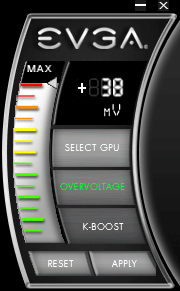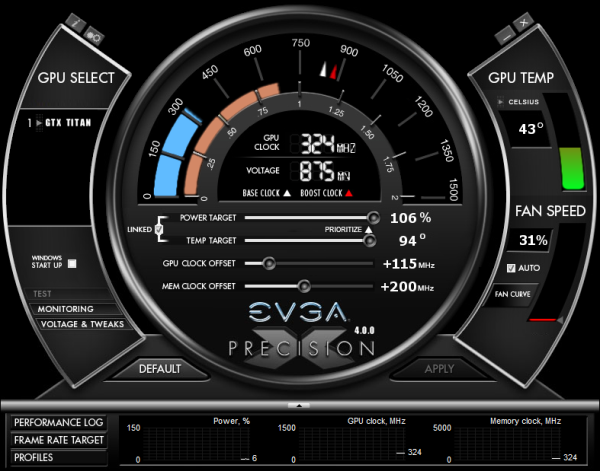NVIDIA’s GeForce GTX Titan Review, Part 2: Titan's Performance Unveiled
by Ryan Smith & Rahul Garg on February 21, 2013 9:00 AM ESTThe Final Word On Overclocking
Before we jump into our performance breakdown, I wanted to take a few minutes to write a bit of a feature follow-up to our overclocking coverage from Tuesday. Since we couldn’t reveal performance numbers at the time – and quite honestly we hadn’t even finished evaluating Titan – we couldn’t give you the complete story on Titan. So some clarification is in order.
On Tuesday we discussed how Titan reintroduces overvolting for NVIDIA products, but now with additional details from NVIDIA along with our own performance data we have the complete picture, and overclockers will want to pay close attention. NVIDIA may be reintroducing overvolting, but it may not be quite what many of us were first thinking.
First and foremost, Titan still has a hard TDP limit, just like GTX 680 cards. Titan cannot and will not cross this limit, as it’s built into the firmware of the card and essentially enforced by NVIDIA through their agreements with their partners. This TDP limit is 106% of Titan’s base TDP of 250W, or 265W. No matter what you throw at Titan or how you cool it, it will not let itself pull more than 265W sustained.
Compared to the GTX 680 this is both good news and bad news. The good news is that with NVIDIA having done away with the pesky concept of target power versus TDP, the entire process is much simpler; the power target will tell you exactly what the card will pull up to on a percentage basis, with no need to know about their separate power targets or their importance. Furthermore with the ability to focus just on just TDP, NVIDIA didn’t set their power limits on Titan nearly as conservatively as they did on GTX 680.
The bad news is that while GTX 680 shipped with a max power target of 132%, Titan is again only 106%. Once you do hit that TDP limit you only have 6% (15W) more to go, and that’s it. Titan essentially has more headroom out of the box, but it will have less headroom for making adjustments. So hardcore overclockers dreaming of slamming 400W through Titan will come away disappointed, though it goes without saying that Titan’s power delivery system was never designed for that in the first place. All indications are that NVIDIA built Titan’s power delivery system for around 265W, and that’s exactly what buyers will get.
Second, let’s talk about overvolting. What we didn’t realize on Tuesday but realize now is that overvolting as implemented in Titan is not overvolting in the traditional sense, and practically speaking I doubt too many hardcore overclockers will even recognize it as overvolting. What we mean by this is that overvolting was not implemented as a direct control system as it was on past generation cards, or even the NVIDIA-nixed cards like the MSI Lightning or EVGA Classified.
Overvolting is instead a set of two additional turbo clock bins, above and beyond Titan’s default top bin. On our sample the top bin is 1.1625v, which corresponds to a 992MHz core clock. Overvolting Titan to 1.2 means unlocking two more bins: 1006MHz @ 1.175v, and 1019MHz @ 1.2v. Or put another way, overvolting on Titan involves unlocking only another 27MHz in performance.

These two bins are in the strictest sense overvolting – NVIDIA doesn’t believe voltages over 1.1625v on Titan will meet their longevity standards, so using them is still very much going to reduce the lifespan of a Titan card – but it’s probably not the kind of direct control overvolting hardcore overclockers were expecting. The end result is that with Titan there’s simply no option to slap on another 0.05v – 0.1v in order to squeak out another 100MHz or so. You can trade longevity for the potential to get another 27MHz, but that’s it.
Ultimately, this means that overvolting as implemented on Titan cannot be used to improve the clockspeeds attainable through the use of the offset clock functionality NVIDIA provides. In the case of our sample it peters out after +115MHz offset without overvolting, and it peters out after +115MHz offset with overvolting. The only difference is that we gain access to a further 27MHz when we have the thermal and power headroom available to hit the necessary bins.
| GeForce GTX Titan Clockspeed Bins | |||
| Clockspeed | Voltage | ||
| 1019MHz | 1.2v | ||
| 1006MHz | 1.175v | ||
| 992MHz | 1.1625v | ||
| 979MHz | 1.15v | ||
| 966MHz | 1.137v | ||
| 953MHz | 1.125v | ||
| 940MHz | 1.112v | ||
| 927MHz | 1.1v | ||
| 914MHz | 1.087v | ||
| 901MHz | 1.075v | ||
| 888MHz | 1.062v | ||
| 875MHz | 1.05v | ||
| 862MHz | 1.037v | ||
| 849MHz | 1.025v | ||
| 836MHz | 1.012v | ||
Finally, as with the GTX 680 and GTX 690, NVIDIA will be keeping tight control over what Asus, EVGA, and their other partners release. Those partners will have the option to release Titan cards with factory overclocks and Titan cards with different coolers (i.e. water blocks), but they won’t be able to expose direct voltage control or ship parts with higher voltages. Nor for that matter will they be able to create Titan cards with significantly different designs (i.e. more VRM phases); every Titan card will be a variant on the reference design.
This is essentially no different than how the GTX 690 was handled, but I think it’s something that’s important to note before anyone with dreams of big overclocks throws down $999 on a Titan card. To be clear, GPU Boost 2.0 is a significant improvement in the entire power/thermal management process compared to GPU Boost 1.0, and this kind of control means that no one needs to be concerned with blowing up their video card (accidentally or otherwise), but it’s a system that comes with gains and losses. So overclockers will want to pay close attention to what they’re getting into with GPU Boost 2.0 and Titan, and what they can and cannot do with the card.











337 Comments
View All Comments
CeriseCogburn - Tuesday, March 12, 2013 - link
ROFL another amd fanboy having a blowout. Mommie will be down to the basement with the bar of soap, don't wet your pants.When amd dies your drivers will still suck, badly.
trajan2448 - Saturday, March 16, 2013 - link
Until you guys start showing latencies, these reviews based primarily on fps numbers don't tell the whole story. Titan is 4x faster than multi GPU solutions in real rendering.IUU - Wednesday, March 20, 2013 - link
Just a thought: if they price titan say at 700 or 500 (that was the old price point for flagship cards), how on earth will they market game consoles, and the brave "new" world of the mobile "revolution"?Like it or not, high tech companies have found a convenient way to get away from the cutthroat competition of the pc-land(from there their hate and slogans like post-pc and the rest) and get a breath of fresh(money) air!
Whether this is also good for the consumer in the long run, remains to be seen, but the fact is, we will pay more to get less, unless something unexpected happens.
paul_59 - Saturday, June 15, 2013 - link
I would appreciate any intelligent opinions on the merits of buying a 690 card versus a Titan, considering they retail for the same pricebravegag - Tuesday, August 13, 2013 - link
I have bought the EVGA nVidia GTX Titan, actually two of them instead of the Tesla K20 thanks to the benchmark results posted in this article. However, the performance results I got are nowhere close to the ones shown here. Running DGEMM from CUDA 5.5 and CUBLAS example matrixMulCUBLAS with my EVGA nVidia GTX Titan reaches no more than 220 GFlop/s which is nowhere close to 1 TFlop/s. My question is then, are the results presented here a total fake?I created the following project where some additional HPC benchmarks of the nVidia GTX Titan are included, the benchmark computing environment is also detailed there:
https://github.com/bravegag/eigen-magma-benchmark
bravegag - Wednesday, August 14, 2013 - link
have anyone tried replicating the benchmark results shown here? how did it go?Tunnah - Wednesday, March 18, 2015 - link
It feels nVidia are just taking the pee out of us now. I was semi-miffed at the 970 controversy, I know for business reasons etc. it doesn't make sense to truly trounce the competition (and your own products) when you can instead hold something back and keep it tighter, and have something to release in case they surprise you.And I was semi-miffed when I heard it would be more like a 33% improvement over the current cream of the crop, instead of the closer to 50% increase the Titan was over the 680, because they have to worry about the 390x, and leave room for a Titan X White Y Grey SuperHappyTime version.
But to still charge $1000 even though they are keeping the DP performance low, this is just too far. The whole reasoning for the high price tag was you were getting a card that was not only a beast of a gaming card, but it would hold its own as a workstation card too, as long as you didn't need the full Quadro service. Now it is nothing more than a high end card, a halo product...that isn't actually that good!
When it comes down to it, you're paying 250% the cost for 33% more performance, and that is disgusting. Don't even bring RAM into it, it's not only super cheap and in no way a justification for the cost, but in fact is useless, because NO GAMER WILL EVER NEED THAT MUCH, IT WAS THE FLIM FLAMMING WORKSTATION CROWD WHO NEEDING THAT FLIM FLAMMING AMOUNT OF FLOOMING RAM YOU FLUPPERS!
This feels like a big juicy gob of spit in our faces. I know most people bought these purely for the gaming option and didn't use the DP capability, but that's not the point - it was WORTH the $999 price tag. This simply is not, not in the slightest. $650, $750 tops because it's the best, after all..but $999 ? Not in this lifetime.
I've not had an AMD card since way back in the days of ATi, I am well and truly part of the nVidia crowd, even when they had a better card I'd wait for the green team reply. But this is actually insulting to consumers.
I was never gonna buy one of these, I was waiting on the 980Ti for the 384bit bus and the bumps that come along with it...but now I'm not only hoping the 390x is better than people say because then nVidia will have to make it extra good..I'm hoping it's better than they say so I can actually buy it.
For shame nVidia, what you're doing with this card is unforgivable